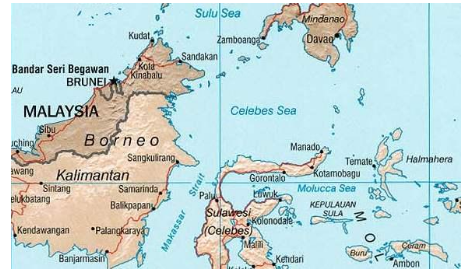The region of the Sulu Sea, just last year branded the ‘New Somalia’, is benefiting from a new trilateral security initiative. However, key challenges remain.
Indonesia, Malaysia and the Philippines launched the INDOMALPHI Trilateral Cooperative Arrangement (TCA) this past summer. The stated goal is to address “the security challenges associated with each country’s border waters”. The initiative is showing promise as a first step towards improving the security architecture in an area where terrorist activity has had major economic impact.
Cargo at risk
Border security is a serious problem in the Sulu Sea, which separates the Southern Philippine region of Mindanao from the island of Borneo.
Each year, 55 million tonnes of cargo and 18 million people transit these waters. But cooperation between surrounding countries’ governments, navies and maritime law enforcement organisations has been weak. Transnational organized crime has proliferated, along with smuggling operations and terrorist activity. Together these activities inflict extensive damage to the economy, tourism and civilian life.

The island clusters surrounding the Sulu and Celebes Seas
The Abu Sayyaf Group (ASG) is a threat in the Sulu and Celebes Seas. Though small-scale and locally-oriented, the ASG is prolific, and targets fishing vessels for lucrative kidnap-for-ransom operations. In 2016, ASG coordinated a number of ship hijackings and kidnappings, taking hostage not only Indonesian and Malaysian fishermen, but also several westerners.
These attacks led Indonesia to temporarily ban coal exports to the Philippines, an $800 million industry, a decision that harmed both economies. This ban was pivotal to moving INDOMALPHI forward.
Seige of Marawi
Another tipping point was the siege of Marawi, a major city in Mindanao. Raging for over five months, this was the first coordinated and sustainable operation involving multiple IS-aligned regional groups – representing a new, asymmetric threat. The Philippine military just recently liberated the city, with most of Marawi completely destroyed.
The Marawi siege underscored how accessible the islands in this region are, an issue all three nations are attempting to address amid continuing emerging risks. For instance, the township of Sarangani, a backwater in the Celebes Sea, has been pinpointed as a critical security flashpoint.
Returning control?
On 16 October, Philippine Defence Secretary Delfin N. Lorenzana claimed the trilateral maritime patrol was going well: ‘We have not had incidents, piracy or kidnappings in the maritime areas of common concern’. There does seem to be evidence to support this assertion, namely the greater speed and accuracy of intra-regional information exchanges, which proved useful in apprehending militants attempting to escape from Marawi. Moreover, military officers recently shot dead the ASG leader and self-declared emir of Southeast Asia, Isnilon Hapilon.
INDOMALPHI builds on several positive security developments in the region in recent years. There was Indonesian President Jokowi’s revised global maritime vision, which adopted a more outward focus, with greater emphasis on interconnectivity and broader collective security.
Jakarta and Manila’s landmark 2014 maritime boundary agreement was also a key step forward, ending an age-old dispute over the Celebes Sea. Similar commitments are now required between Malaysia and the Philippines. These countries have had multiple disputes over Sabah (nominally a Malaysian state in the north of Borneo), notably the military standoff in Lahad Datu in 2013.
Broadening partnerships
There is scope to include other members and organisations in the initiative, in view of the broader regional security challenges. ASEAN has the potential to address border threats. Assistance could also be forthcoming from Australia, Japan, and the United States, given its support for Singapore in the Straits of Malacca. Indeed, Singapore is a particularly strong potential partner, given its staunch defense capabilities.
Singapore already has the required infrastructure and technologies in place from past joint initiatives with Indonesia and Malaysia. Established in April 2009, Singapore’s Information Fusion Centre (IFC) is an important hub for cooperation on maritime security threats.
The Maritime Command Centres in Tarakan (Indonesia), Tawau (Malaysia) and Bongao (Philippines) are not of equal calibre, since these centers possess less advanced radar network capabilities. Without the IFC, a better quality of infrastructure is necessary to facilitate real-time information sharing and the inter-operability of emergency protocols.
Tempered optimism
Ultimately, the goal is to increase land cooperation between all affected countries. This includes plans to strengthen border controls and immigration checks in and around the Sulu region, curbing covert militant movements.
Malaysia and Indonesia will construct five command posts at key points along the Sabah, Sarawak and Kalimantan borders. A newly-renovated border post on Balut Island, Sarangani, will function as an inter-agency monitoring station on the Celebes Sea.
Success will depend on whether each country trusts the collaborative process and periodically convenes with partners to discuss progress and targets. Over time, familiarity with operational routines and processes, such as cross-nation hand-offs and emergency protocols, should develop.
But the biggest risk to INDOMALPHI is that the initiative remains at the mercy of political transitions in each country. Only sustained efforts will decrease the multiple risks discussed.
http://globalriskinsights.com/2017/10/can-sulu-sea-become-secure-new-initiative/

No comments:
Post a Comment
Note: Only a member of this blog may post a comment.